This post originally appeared on LandPortal.
Mozambique’s 1997 land law recognises land rights acquired through customary practice and good faith occupancy, even without a formal title. However, the lack of transparent public confirmation or documentation can lead to conflict. Sr. Land and Resource Governance Advisor Karol Boudreaux discusses how a partnership between USAID and agribusiness Grupo Madal has helped the company and local communities address long-standing land-access issues and improve livelihoods.
What is causing conflict over land rights?
Mozambique’s land laws allow citizens to have their land rights confirmed by the verbal testimony of other community members – and this testimony creates a legal claim that is just as valid as title documentation, even without documented proof. Despite this, the lack of documentation of community and individual land rights can lead to tensions between neighbours over boundaries or rights to specific areas. It also places many Mozambicans in a weak position when investors seek rights to their land for forestry, farming, and other uses.
In central Mozambique’s Zambézia province, due to a lack of available farmland, roughly 50,000 smallholder farmers have started growing their crops on unused land legally held by the agribusiness Grupo Madal. Most of these farmers are women, using small tracts of land to grow mostly food for their families. At the same time, in the communities adjacent to Grupo Madal’s farms, thousands of others have acquired land rights, but very few have documented proof. This lack of documentation has led to tensions and conflicts between people within these communities competing over scarce land.
USAID’s Integrated Land and Resource Governance (ILRG) programme is partnering with Grupo Madal and a local civil society organisation (CSO), the Associação de Apoio ao Desenvolvimento (Development Support Association or NANA) to raise awareness of land and resource rights and improving tenure security, while addressing harmful gender norms and promoting women’s empowerment and economic security.
The USAID-Grupo Madal partnership
In 2016, Grupo Madal changed ownership, prompting a shift away from an estate-based production model, which had been in place since Mozambique’s colonial period, to a more inclusive business model designed to intentionally integrate and benefit neighbouring communities. The company’s new approach has included an initiative to help resource-poor farmers who were using Madal land to transition into a more secure situation. The goal was to help the farmers feed their families and earn income, while providing a source of revenue for the company.
How the public-private partnership works
The partnership initially worked with 3,300 smallholder farmers (over 67% were women) from 14 communities adjacent to four Madal plantations. Through an innovative model for ‘ingrowers’ (mostly landless women farming on Madal land) and ‘outgrowers’ (women and men farmers with land in neighbouring communities), the partnership seeks to include these smallholder farmers in Madal’s supply chains.
After an initial assessment to gauge community needs, the partnership has focused on introducing land-use agreements and farming contracts for ingrower families to strengthen their land-use rights and provide an opportunity to enter commercial value chains to help increase incomes. Families farming on Madal lands now have access to larger plots, allowing them to grow and sell commodities to Madal and grow food crops for household consumption. Madal specifies the crops it requires, provides appropriate inputs and technical advice, and guarantees to buy the resulting harvest.
Madal has also recruited seven community members, four of them women, with farming experience and communication skills to support the company’s extension officers and increase engagement within the communities. Most Madal extension agents are men, so engaging women as community facilitators has improved the company’s ability to reach women farmers. This community-based extension model inspires other women by increasing their technical skills, self-esteem, and confidence.
Now, with greater tenure security, these farmers have also organised themselves into producers’ clubs. “Before, each one of us women farmers worked separately. Now we are organised in producers’ clubs,” said Florinda Francisco, an ingrower farmer. “We have confidence in working with Madal and we want to sell our production to the company because they are the ones who made the land available for us.”
Documenting and managing community lands
Neighbouring outgrower communities have also received help to document their collective land rights and their individual farms. Similar to the ingrower agreement, some may decide to sign contracts to produce crops for Madal, receiving inputs and technical support.
With support from NANA, communities clarify their boundaries using mobile applications to secure tenure (MAST), a participatory land-documentation approach that improves transparency and equity and emphasises social inclusion and gender equality. The approach begins by raising communities’ awareness of their legal land rights. Communities then establish land associations to manage their land and natural resources, engage in participatory land-use planning, and develop community land-use regulations.
Impacts and next steps
Since 2020, the USAID-Madal partnership has mapped 8,000 hectares in 14 communities adjacent to Madal lands through participatory processes, enabling 6,500 families to receive certificates of community land rights from the provincial government. A total of 1,300 ingrower farmers (85% women) have entered into land-use agreements on Madal lands, and 2,000 outgrower farmers (55% women) have delimited their family lands, opening up opportunities for them to benefit from contract farming.
The partnership’s approach to strengthen land claims and build trusting and beneficial relationships between companies and neighbouring farmers is uncommon in Mozambique. It has the potential to create a viable model for responsible land-based investment that benefits private-sector actors and communities, and improves women’s economic security. The Mozambique Ministry of Agriculture and Rural Development has already expressed interest in supporting expansion of this innovative model to other companies and provinces.
Grupo Madal sees this activity as a major opportunity to clarify land rights and build trust with communities. The partnership has helped Madal to focus on rehabilitating its historically unused landholdings and integrating communities into their supply chain with benefits for both. The company has also welcomed USAID’s support in engaging with farmers – most of whom are women – in a gender-responsive way.
Sensitising private companies to land-related issues and supporting them to set up inclusive models can benefit communities and help secure their long-term rights to access and use land. Despite inherent power imbalances, with support, farmers can work with companies to clarify their land holdings, giving them the security they need to invest in their plots. Smallholders can also increase their access to inputs, technical skills, and markets, thereby improving their livelihoods, food security, and well-being. Public-private partnerships can be particularly beneficial for women, allowing them to feed their families while helping to earn additional income. Working with companies and CSOs can help ensure community rights and needs are considered, and help aggregate community voices for greater impact. Further support from the Government of Mozambique is essential to scale-up and institutionalise these approaches. Taking this holistic approach, USAID is helping improve livelihoods for thousands of Mozambique’s women and men.







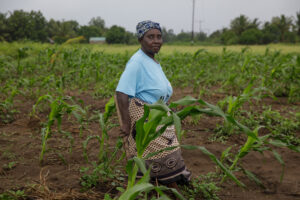 Floriana Mariano Jose, 69, never had her own land. Last year, she received the long-term right to use a half-hectare plot in Inhangulue, Mozambique, from local agroforestry company Grupo Madal. This was revolutionary for Floriana: her plot allowed her to move beyond subsistence farming and enter commercial value chains, growing coconuts and beans to sell. She signed a commercial farming agreement with Madal, which is providing her with seeds, guidance on how to care for these crops, and a guaranteed market for her produce. She feels confident having her land use rights documented on paper, knowing that her daughters and granddaughters will be able to continue to work this land in the years to come. As she said: “In addition to a guaranteed buyer and support to increase our production, there is a lot of work within the community to support women, to decrease violence against women, and to ensure that our husbands know they can’t take the money we make selling coconut and beans.”
Floriana Mariano Jose, 69, never had her own land. Last year, she received the long-term right to use a half-hectare plot in Inhangulue, Mozambique, from local agroforestry company Grupo Madal. This was revolutionary for Floriana: her plot allowed her to move beyond subsistence farming and enter commercial value chains, growing coconuts and beans to sell. She signed a commercial farming agreement with Madal, which is providing her with seeds, guidance on how to care for these crops, and a guaranteed market for her produce. She feels confident having her land use rights documented on paper, knowing that her daughters and granddaughters will be able to continue to work this land in the years to come. As she said: “In addition to a guaranteed buyer and support to increase our production, there is a lot of work within the community to support women, to decrease violence against women, and to ensure that our husbands know they can’t take the money we make selling coconut and beans.”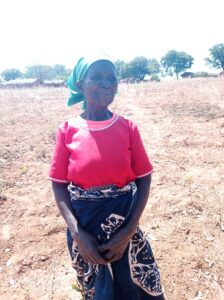 Joyce Daimoni is a 70 year old woman with physical disability who raised seven children and over 30 grandchildren in Chinthankhwa, Malawi. Following custom, she moved to her husband’s village when they married. Custom also dictates that once she left her maternal home, she was not allocated land there and would rely on his land for life. She has farmed the land her whole life, growing groundnuts and maize for the family to eat and sell. When a customary land documentation program started in her village this year, others in the community tried to stop her family from registering their land, saying the land belonged to the clan. Joyce sought help from the local Customary Land Committee and was referred to the Customary Land Tribunal, who decided in favor of Joyce and her husband. They were able to finally register their land, in both their names, and Joyce is relieved. “This means we are still going to be using the land. I am happy we can still cultivate the land and our children will be able to use this land too.”
Joyce Daimoni is a 70 year old woman with physical disability who raised seven children and over 30 grandchildren in Chinthankhwa, Malawi. Following custom, she moved to her husband’s village when they married. Custom also dictates that once she left her maternal home, she was not allocated land there and would rely on his land for life. She has farmed the land her whole life, growing groundnuts and maize for the family to eat and sell. When a customary land documentation program started in her village this year, others in the community tried to stop her family from registering their land, saying the land belonged to the clan. Joyce sought help from the local Customary Land Committee and was referred to the Customary Land Tribunal, who decided in favor of Joyce and her husband. They were able to finally register their land, in both their names, and Joyce is relieved. “This means we are still going to be using the land. I am happy we can still cultivate the land and our children will be able to use this land too.”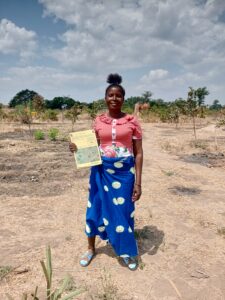 When her husband passed away 15 years ago, Mary Nkhowani, 55, and her 5 children returned to her home village of Muzumbwa in Chifunda Chiefdom, Zambia, to grow maize for subsistence. She went from cultivating her husband’s land to cultivating her father’s land, never imagining women could hold land in their own right. When her father died, she inherited his land. But in rural Zambia, it is often not easy for women – especially widows – to hold land. Twice Mary experienced land grabbing by members of her extended family. Once a USAID-supported land documentation program began working in her village, Mary attended sensitization meetings and learned that women can own land; she then registered her land. Motivated by this life-changing experience, Mary volunteered to serve on the village land committee to help other women have land documented in their own names. “The certificate puts a seal on the land that it is mine and no one can grab it. It means peace for me in life and in death because there were a lot of conflicts over land. Everyone wants land and if you are not a man, no one thinks you are entitled. I feel very happy that the future of my children and grandchildren is now secure.”
When her husband passed away 15 years ago, Mary Nkhowani, 55, and her 5 children returned to her home village of Muzumbwa in Chifunda Chiefdom, Zambia, to grow maize for subsistence. She went from cultivating her husband’s land to cultivating her father’s land, never imagining women could hold land in their own right. When her father died, she inherited his land. But in rural Zambia, it is often not easy for women – especially widows – to hold land. Twice Mary experienced land grabbing by members of her extended family. Once a USAID-supported land documentation program began working in her village, Mary attended sensitization meetings and learned that women can own land; she then registered her land. Motivated by this life-changing experience, Mary volunteered to serve on the village land committee to help other women have land documented in their own names. “The certificate puts a seal on the land that it is mine and no one can grab it. It means peace for me in life and in death because there were a lot of conflicts over land. Everyone wants land and if you are not a man, no one thinks you are entitled. I feel very happy that the future of my children and grandchildren is now secure.”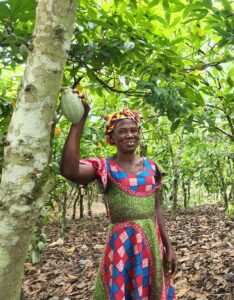 When Grace Annison, 60, got married, she moved to her husband’s cocoa farm in Asorefie, Ghana. Over the past 40 years, Grace has worked on this land every day: during the cocoa season she prunes the trees, harvests the cocoa pods, and dries the beans. Throughout the year she plants pepper, cassava, plantains, and tomatoes for her family to eat and to sell, a crucial source of income in the cocoa off-season. The land and the fruits of her labor enabled Grace to raise her six children. However, as it is customary in the area, the land is registered in her husband’s name only. Grace hopes that if something happens to her husband, nobody will take the land away from her. “I hope to continue to farm the land to achieve my next dream to build a comfortable house for my family.”
When Grace Annison, 60, got married, she moved to her husband’s cocoa farm in Asorefie, Ghana. Over the past 40 years, Grace has worked on this land every day: during the cocoa season she prunes the trees, harvests the cocoa pods, and dries the beans. Throughout the year she plants pepper, cassava, plantains, and tomatoes for her family to eat and to sell, a crucial source of income in the cocoa off-season. The land and the fruits of her labor enabled Grace to raise her six children. However, as it is customary in the area, the land is registered in her husband’s name only. Grace hopes that if something happens to her husband, nobody will take the land away from her. “I hope to continue to farm the land to achieve my next dream to build a comfortable house for my family.”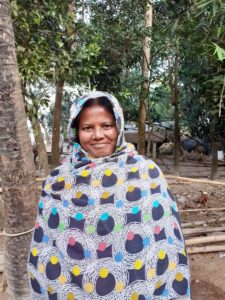 Land is the most important asset for farmer Sumsurnehar Begam. Early in her marriage, Sumsurnehar and her husband farmed two plots of land in West Bengal, India: a small piece of land that he had inherited and another small plot they purchased. However, they never updated their land records, and continued to farm without any formal proof of ownership for years, unaware of the risks. After saving for many years, in 2020 they decided to buy a third plot. By this time, Sumsurnehar had attended land literacy training supported by USAID and PepsiCo and knew the importance of formalizing the land transaction. As the only member of the family who is literate, she took charge and was able to complete the registration process by herself, ensuring that her name was included on the title. This gave her economic independence and made her future more secure. For the past two years she has been cultivating rice and potatoes on this land, independently managing the small farming business. With her increased confidence as a farmer, she joined other women to lease land to grow potatoes and formally enter into the potato supply chain for PepsiCo. “I feel confident that I have my own land and the proper documents to prove it. This is an asset for my good and bad days.”
Land is the most important asset for farmer Sumsurnehar Begam. Early in her marriage, Sumsurnehar and her husband farmed two plots of land in West Bengal, India: a small piece of land that he had inherited and another small plot they purchased. However, they never updated their land records, and continued to farm without any formal proof of ownership for years, unaware of the risks. After saving for many years, in 2020 they decided to buy a third plot. By this time, Sumsurnehar had attended land literacy training supported by USAID and PepsiCo and knew the importance of formalizing the land transaction. As the only member of the family who is literate, she took charge and was able to complete the registration process by herself, ensuring that her name was included on the title. This gave her economic independence and made her future more secure. For the past two years she has been cultivating rice and potatoes on this land, independently managing the small farming business. With her increased confidence as a farmer, she joined other women to lease land to grow potatoes and formally enter into the potato supply chain for PepsiCo. “I feel confident that I have my own land and the proper documents to prove it. This is an asset for my good and bad days.”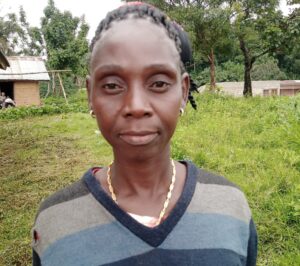 Like most rural women in Zor-Ganaglay community in Liberia, Mamie Kpahn depends on the land and natural resources around the Blei Community Forest for her livelihood. Responding to increasing pressure over natural resources, the Liberian government has enacted legislation and processes to allow communities to self-identify, create communal governance structures, and obtain formal documentation of their community lands. Mamie notes that even though women often use the land more than men, they have been traditionally excluded from decision making around land in the community. After hearing about the importance of inclusive participation, she decided to run for her local land governance committee and was elected as chairperson. Today she participates in every step of the decision-making process related to the community land. Recently she attended a boundary harmonization meeting and helped resolve boundary conflicts between hers and a neighboring community. “As a woman, I was proud to be in this meeting and be part of the decision making to bring us together as neighbors. I am happy that the two communities can be in peace and work together. This will help our children manage our land in the future.”
Like most rural women in Zor-Ganaglay community in Liberia, Mamie Kpahn depends on the land and natural resources around the Blei Community Forest for her livelihood. Responding to increasing pressure over natural resources, the Liberian government has enacted legislation and processes to allow communities to self-identify, create communal governance structures, and obtain formal documentation of their community lands. Mamie notes that even though women often use the land more than men, they have been traditionally excluded from decision making around land in the community. After hearing about the importance of inclusive participation, she decided to run for her local land governance committee and was elected as chairperson. Today she participates in every step of the decision-making process related to the community land. Recently she attended a boundary harmonization meeting and helped resolve boundary conflicts between hers and a neighboring community. “As a woman, I was proud to be in this meeting and be part of the decision making to bring us together as neighbors. I am happy that the two communities can be in peace and work together. This will help our children manage our land in the future.”

















 Positions included land surveyors, legal experts, knowledge management specialists, and social workers with a unique set of skills related to land rights. Ten teams made up of four diverse professionals used their skills and tools to reach rural communities, effectively communicate, formalize a property, and register a land title. The pilot employed some 60 qualified professionals, but only 6 of them were actually from Ovejas.
Positions included land surveyors, legal experts, knowledge management specialists, and social workers with a unique set of skills related to land rights. Ten teams made up of four diverse professionals used their skills and tools to reach rural communities, effectively communicate, formalize a property, and register a land title. The pilot employed some 60 qualified professionals, but only 6 of them were actually from Ovejas.











